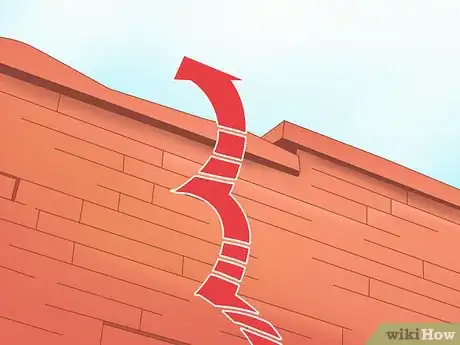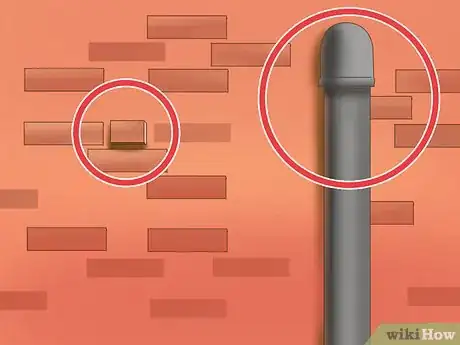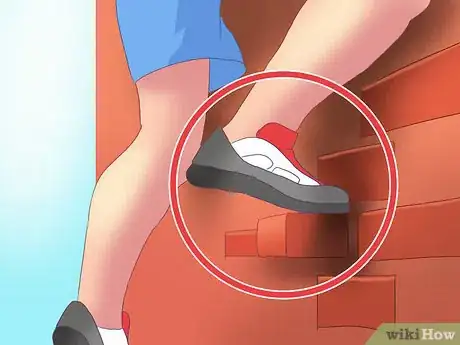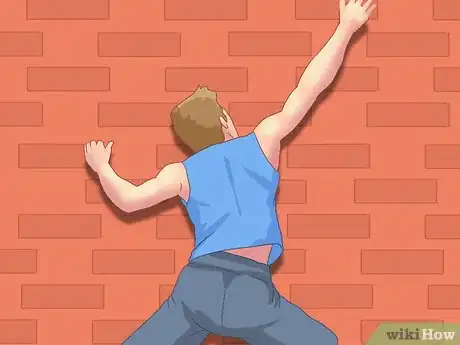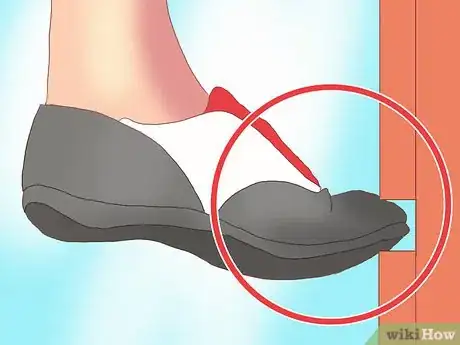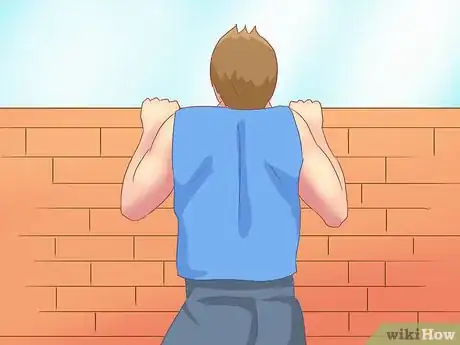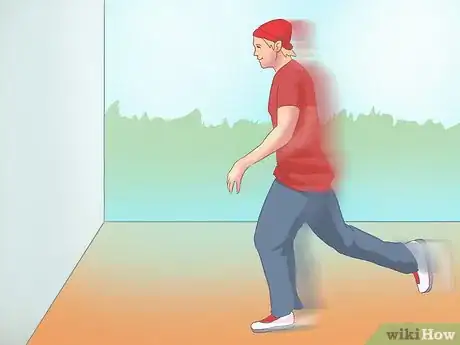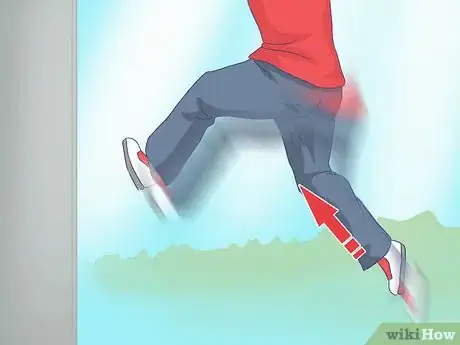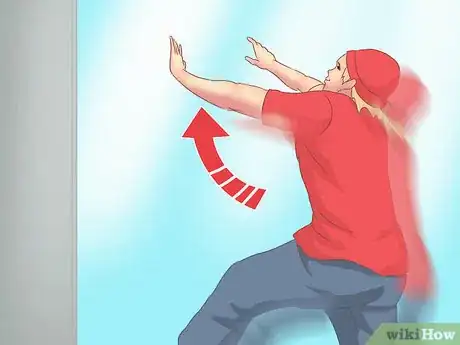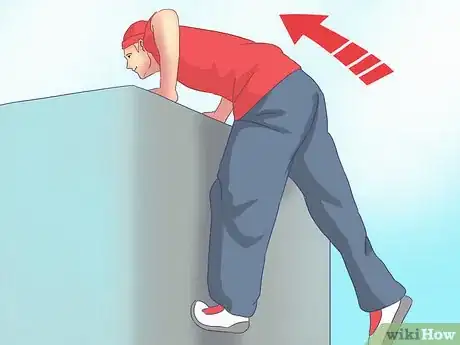This article was co-authored by wikiHow Staff. Our trained team of editors and researchers validate articles for accuracy and comprehensiveness. wikiHow's Content Management Team carefully monitors the work from our editorial staff to ensure that each article is backed by trusted research and meets our high quality standards.
There are 10 references cited in this article, which can be found at the bottom of the page.
This article has been viewed 53,447 times.
Learn more...
Climbing a brick wall can be a challenging task and requires you to have a fair amount of upper body strength. You can climb a brick wall barehanded with standard climbing techniques. You can also try parkour techniques to essentially run up the wall.
Steps
Using Climbing Techniques
-
1Plan your route first. Regular climbing techniques will only work if some of the grout between bricks is missing or if bricks are jutting out. Basically, if the wall is perfectly smooth, you're not going to be able to climb it with standard techniques. Look up the wall, and see if you can find enough handholds and toeholds to get you up the wall.[1]
- Try to visualize your climb up the wall. For instance, point out places you could get a grip or toehold, and visualize using them to actually climb it. Assess whether you can make it or not.[2]
- You must also have considerable strength in your fingers in order to successfully complete this technique, especially in your fingertips. If you do not think you can support the majority of your body weight using your fingers, you should try another technique.
-
2Make it easier on yourself if possible. Look for items that jut out vertically to make it easier to climb. For instance, if a pillar of brick juts out, you can wrap yourself around it for better climbing. Similarly, you can use a solid drainpipe to help you climb.[3]Advertisement
-
3Wear the right shoes. The best shoes to wear will be those that allow you to catch edges. For instance, shoes that have a sharp edge can allow you to grip the wall from the side of the shoe as well as the front. In addition, the shoe needs to have good support throughout the sole so that when you grip with your toes, it can support the whole foot.[4]
- Also, choose shoes that have good traction to help create friction when you need it.
-
4Climb up by finding your first foothold. You need to balance your weight mostly on your feet. Your hands are primarily there for balance. After you find your first foothold, look for handholds to support you as pull yourself up. Step up onto a foot hold, balancing your weight on the friction. Grab a handhold to help pull yourself up.[5]
- When looking for footholds, pick ones that provide the most contact possible with your foot. In other words, look for the widest spaces and holds.[6]
- The closer the foothold is to the ground, the easier it will be to pull yourself up. If you pick one that's too high, you'll have a harder time getting off the ground. When looking, try to pick ones that are further down.
-
5Look for more foot- and handholds. Alternate moving your feet and hands up the wall. As you look for places, don't be afraid to turn your foot to the side to help you get a better hold.[7]
- With your other hand, grab the next nearest hold that you can reach for comfortably and securely. Find the next hold with your foot. Pull yourself up using both your hand and foot before looking for your next hold.
- Make sure to check bricks before placing weight on them. Loose bricks could cause you to tumble. To check one, reach your hand out and jiggle it. If it seems like it might fall out, skip it.
-
6Cling close to the wall. Putting yourself as close to the wall as possible helps you to keep your balance. It pushes your center of gravity over your feet, making it easier to hang on.[8]
-
7Position your shoe in the space between bricks as you climb. To give yourself much needed additional support, bend your legs at the knee and climb along the bricks as you pull yourself up with each fingertip grip. The sharp edge of your shoe sole should be placed into the indentation formed between bricks, even if there are no gaps in the grout there.[9]
- If you can't get your foot in a space, you can try "smearing," where you basically use friction over cracks to hold your foot. Place your foot flat against the wall to grip into the cracks. Only use this type of hold very quickly as you're moving to a new position.[10]
-
8Pull yourself up once you reach the upper ledge. Once both hands reach the mantel on the wall, shift your feet so that they are approximately at the same level. Step off with your dominant foot to propel yourself over the wall.
- Make sure that the palms of your hands are flat on the surface before pushing off.
- Alternatively, you could swing your dominant leg over the upper edge of the wall and hook the heel of your leg over the side. Use the strength of your arms and dominant leg to swing your body sideways over the top of the wall.
Using Parkour Techniques
-
1Wear the right shoes. For parkour, you need to wear thin-soled shoes that have a one-piece sole. Thin soles let you feel the wall better, improving your technique, while one-piece soles won't rip off in pieces as easily. The shoe should have a well-defined arch to help you dig in your heels. It should also have a soft rubber for the best grip.[11]
- If you want to learn parkour in a more controlled, safe environment, look for a parkour gym in your area. They'll have coaches on hand to help you learn the techniques.
-
2
-
3Use your non-dominant leg to push off. As you reach the wall, push off the ground with your non-dominant leg. You should be close enough to the wall that you can easily hit it with the other leg. In other words, you need to be within a foot or two. Basically, you are trying to push yourself as far up the wall as you can.[14]
-
4Lift your arms. Immediately as you get to the wall, push your arms up. You need to be ready when you approach the top of the wall to grasp it.[15]
-
5Catch the wall with your dominant leg. Using the ball of your foot, plant your foot on the wall. Use that foot to change your horizontal motion to vertical motion, pushing yourself up the wall.[16] As you do, be sure to lean in towards the wall, as it will keep you moving upwards rather than away from the wall.[17]
-
6
-
7Pull yourself up. Grab the top of the wall with both hands. Pull yourself upwards. As you reach the top, push yourself like you're climbing out of the pool. You can then simply push until you can put your foot on the wall and stand up.[20] Alternatively, you can swing a leg up to the side, pushing it over and drop down the other side of the wall.
Community Q&A
-
QuestionWhat is the best wall height for beginners? My wall is 5'5'' and I'm still having problems after a month.
 RaifCommunity AnswerThe best wall height should be basically your height or an inch or two higher than your height. Start with these and then go with higher walls.
RaifCommunity AnswerThe best wall height should be basically your height or an inch or two higher than your height. Start with these and then go with higher walls. -
QuestionIs this method of climbing used by ninjas?
 Community AnswerNot exactly as a ninja would likely find quicker and stealthier ways to climb a wall, but we can say that these techniques are the basis for ninja techniques (with some further refinement).
Community AnswerNot exactly as a ninja would likely find quicker and stealthier ways to climb a wall, but we can say that these techniques are the basis for ninja techniques (with some further refinement). -
QuestionIs it safe to do this by myself?
 Community AnswerYes, because if you do it with other people they will only get in your way. That said, you should have a spotter or someone with you in case you fall.
Community AnswerYes, because if you do it with other people they will only get in your way. That said, you should have a spotter or someone with you in case you fall.
Warnings
- Attempt each of these methods at your own risk. Your results may vary based on the height and condition of the wall, as well as the amount of upper body strength you possess. For a safer approach, consult a professional climber.⧼thumbs_response⧽
References
- ↑ http://www.indoorclimbing.com/Climbing_Technique.html
- ↑ http://www.indoorclimbing.com/Climbing_Technique.html
- ↑ http://www.ivencia.com/index.html?/dynamicarts/climbing.htm
- ↑ http://www.ivencia.com/index.html?/dynamicarts/climbing.htm
- ↑ http://www.wilderness-survival.net/mountain-climbing/holds/
- ↑ http://www.wilderness-survival.net/mountain-climbing/holds/
- ↑ http://www.wilderness-survival.net/mountain-climbing/holds/
- ↑ http://www.indoorclimbing.com/Climbing_Technique.html
- ↑ http://www.ivencia.com/index.html?/dynamicarts/climbing.htm
- ↑ http://www.wilderness-survival.net/mountain-climbing/holds/
- ↑ http://parkourpedia.com/other/shoes-for-parkour
- ↑ https://www.researchgate.net/publication/329009452_Determinants_of_optimal_leg_use_strategy_horizontal_to_vertical_transition_in_the_parkour_wall_climb
- ↑ http://breakingmuscle.com/parkour/go-run-up-a-wall-how-to-do-a-parkour-wall-run
- ↑ http://breakingmuscle.com/parkour/go-run-up-a-wall-how-to-do-a-parkour-wall-run
- ↑ http://www.learnmoreparkour.com/how-to-parkour-wall-run.html
- ↑ http://breakingmuscle.com/parkour/go-run-up-a-wall-how-to-do-a-parkour-wall-run
- ↑ http://www.learnmoreparkour.com/how-to-parkour-wall-run.html
- ↑ http://www.learnmoreparkour.com/how-to-parkour-wall-run.html
- ↑ http://www.wired.com/2012/07/can-you-run-up-a-wall/
- ↑ http://breakingmuscle.com/parkour/go-run-up-a-wall-how-to-do-a-parkour-wall-run
